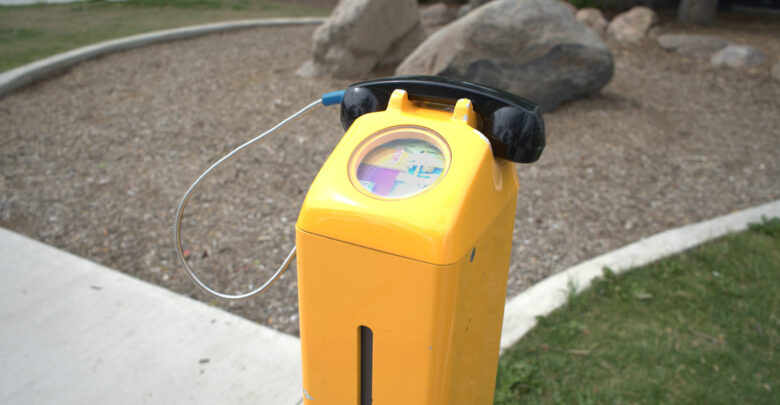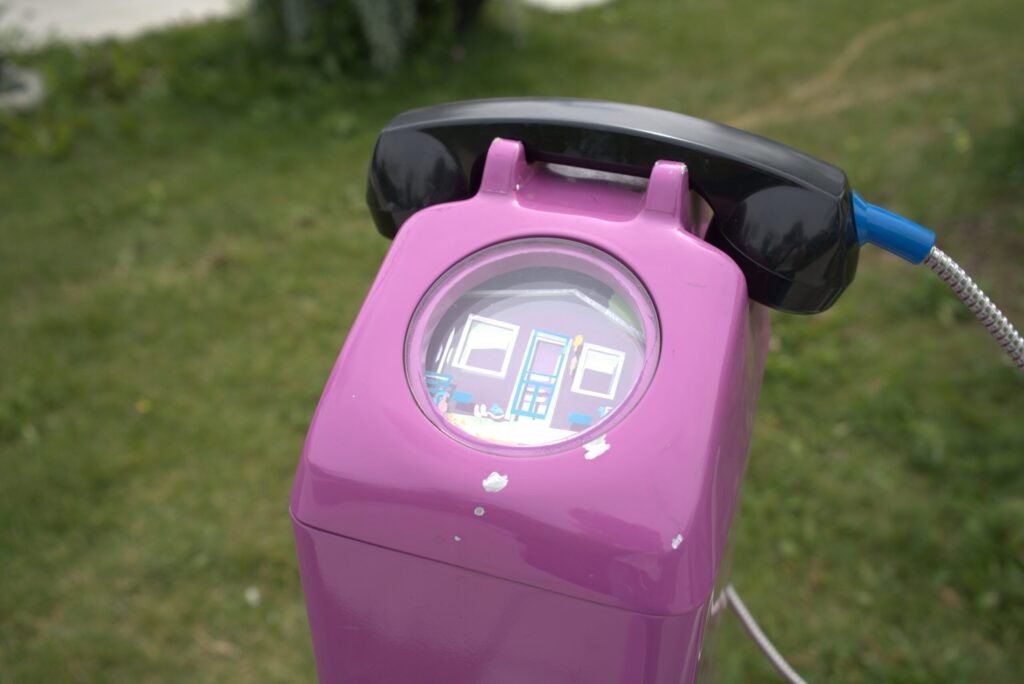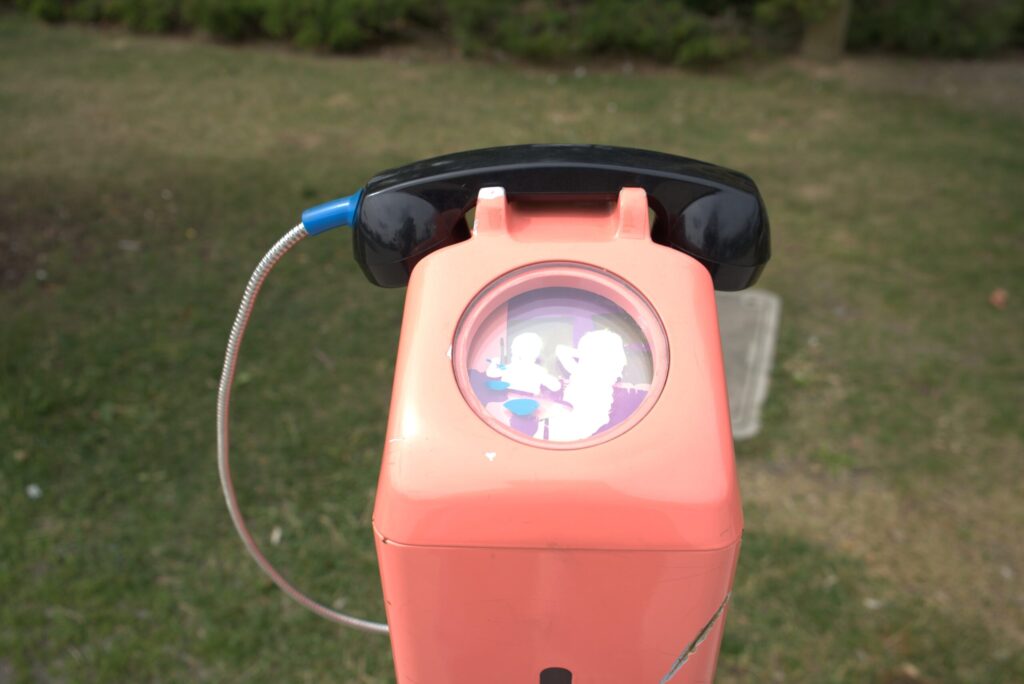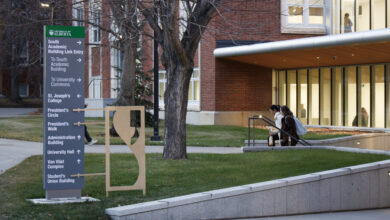“Play It By Ear:” Bringing old technology to life to build new connections
“We saw the opportunity to kind of make connections between people who are using the space in a varied ways," Wayne Garrett says.
 Leah Hennig
Leah HennigOld-fashioned telephones might largely be a thing of the past, but two Calgary artists have given them a new life. Caitlind r.c. Brown and Wayne Garrett created a public art installation in Edmonton’s Butler Memorial Park all about connections and missed connections.
Brown told The Gateway that the artwork was tailored to the location of the park. Butler Memorial Park is situated between a bus station and an old Government of Alberta telephones building.
“We saw the opportunity to kind of make connections between people who are using the space in a varied ways, and so there are a lot of people passing through or, you know, going between modes of transportation,” Garrett said.
“For us, it seemed like there’s a good amount of flow-through traffic and we could maybe see an opportunity there to create a situation that would enable strangers to connect.”
Reworking old technology in new times
Brown explained that the Edmonton Arts Council initially hired the pair for the project in 2020, but the installation was delayed until 2023 due to the COVID-19 pandemic. She said that during and after the pandemic, telephones were a bit of an object of fear, given the tactility of them.
“While this project was put on hold, this project also became extra important because it was speaking to connections over distance,” Brown said. “During that time, I think it also built a bit more resonance because of the context of the pandemic.”
But that wasn’t the only challenging part of putting the project together.
“With this one, there are a few elements to bring together. So the physical telephones themselves, we had to design and develop how we wanted them to look and what sort of shape they need to be to fit the function,” Garrett explained.
He said they consulted with one of the few remaining pay-phone service providers in Alberta about the different technologies and handsets they could use.
To actually make the physical installation, they worked with an Edmonton-based foundry to cast the aluminium cradles. They then machined them to fit into the steel columns.
The casts also included little recesses for window dioramas.
Brown explained that the dioramas are an ode to the old home phones. Where an old phone would have a rotary dial, Brown and Garrett’s phones have windows to dioramas.
“Each window is like a flat-packed diorama of a photograph that was submitted to us by members from the community of a place that feels like home,” Brown said.
Brown added that it gives the phones more of a visual possibility for people who maybe can’t hear.
“We’ve watched people from … different walks of life end up in conversations across these phone lines,” Brown says
But the phones don’t just look pretty. If you pick one up, another one will ring somewhere else in the park.
“We use sort of off-the-shelf components, just to kind of piggyback on the resiliency and the reliability of systems that have already been developed,” Garrett said. “The whole piece is networked by what’s called a [private branch exchange] (PBX) hub, which is a traditional kind of multi-channel, multi-extension telephone system.”
“It’s pretty interesting to draw from an existing technology like this, and we do that a lot throughout our practice. We’ll work with found materials quite frequently,” Brown added. “And it’s this idea of not reinventing the wheel, but recontextualizing the wheel.”
Brown said they liked the idea of strangers being able to have conversations with each other.
“We’ve seen it happen a couple of times in our visits to Edmonton,” Brown said. “We’ve watched people from across different generations, different socioeconomic groups, different walks of life end up in conversations across these phone lines.”
She said some of the conversations are brief and funny, others are longer.
“We’re hoping that people will find connections with people they might not otherwise have connected with,” Brown said.
But, if no one answers when you pick up the phone, there are voicemail prompts on each phone.
“They can range anything from ‘leave an improvised poem’ to ‘leave a gratitude or a grievance’ or some kind of prompt like that, or something that reminds you of home,” Garrett explained. “And so it’s this system of messages that we’re collecting through the telephones.”
“The thing about this artwork is that this community is a really kind of powerful context,” Brown says
“Play It By Ear” has made it onto a list of the top 100 CODAawards and is in the running for the People’s Choice award.
While the international recognition is exciting for the duo, the community acceptance is far more rewarding.
“The thing about this artwork is that this community is a really powerful context. Butler Memorial Park is literally an outdoor living space for a number of people,” Brown said. “It’s a community that suffered a lot in the last couple of years, just between COVID[-19] making it really hard for the local businesses to function. And then the building of the new LRT line has been really, really hard on this neighbourhood.”
“The actual acceptance of the space, of the people who use the park every day has been kind of more gratifying,” she said.
Brown said that when they visit the park, they like to introduce themselves to people who are there all day. She said that the last time they visited, a group of young people actually started explaining to them how the telephones worked, not realizing that they were the artists behind the work.
“That was such a sign of acceptance, and I feel like that in itself was more gratifying than any possible awards nomination, although I don’t want to downplay being on this list,” she said.






